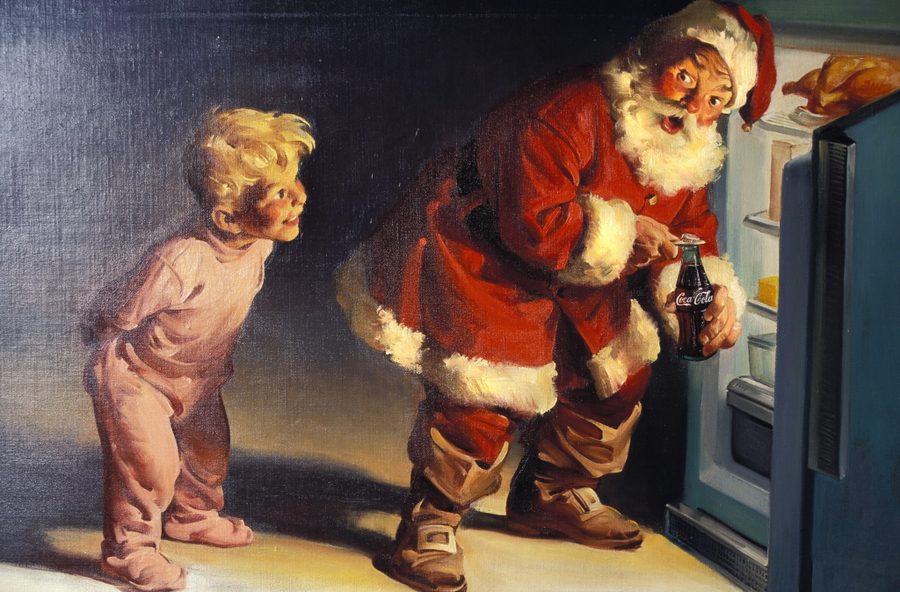We Can Reclaim Christmas from Capitalism
The case for getting rid of Santa and ending the commodification of the holiday season.
Valerie Vande Panne

First posted in 2018, this holiday favorite is even more relevant today.
The way Americans celebrate Christmas today is not the way people celebrated this season just a few generations ago.
In fact, for thousands of years, humans celebrated the winter solstice and the Christmas holiday with meaningful traditions that included prayer, and rituals from special fires to honoring plants for fertility.
Hysterical shopping was not a part of any of these celebrations — until recently.
Worse, the marketing for the hysterical shopping has twisted Santa Claus into the singular secular god we culturally honor in the United States: His image is splashed everywhere, supposedly not as a symbol or god to worship, but as a decorative marketing tool. Yet families in the United States place statues of him in their homes and leave milk and cookies out for him and carrots for his reindeer on the night before Christmas.
Seems quite pagan, doesn’t it? What are we really doing when we carry on this tradition?
People will validate the tradition by pointing to Santa Claus’s pagan origin as a bringer of gifts in the heart of winter, from the Germanic pagan Yule festival and their god Wodan (strikingly similar to the Norse god Odin) to the Dutch Sinterklaas and the English Father Christmas.
Or, for those uncomfortable with pagan rites, Santa Claus can be traced back to the legend of the 4th century Saint Nicholas as a Greek-Christian bishop known for giving gifts. This belief quenches both the need to honor the Saint and absolves followers of heathenism.
But when you see Santa today, all fat and white and rosy-cheeked, you’re seeing an image created, promoted and marketed by the Coca-Cola Company. Michigan artist Haddon Sundblom created the Santa Claus we all know so well in 1931, for Coke’s “Thirst Knows No Season” campaign.
Sundblom modeled his Santa on A Visit from St. Nicholas, the 1822 poem by Clement C. Moore. While people often point to that poem as the defining element of Santa Claus’s style, or to Thomas Nast’s versions of Santa Claus for Harper’s, it wasn’t until Sundblom and Coke codified the Claus in mass advertising that the world adopted and accepted the image. Prior to 1931, Santa Claus was depicted in all sorts of ways in mass media — from an old Diogenes-type man to a bishop to a sprite-like troll.
That makes Coke’s Santa quite possibly the first time a corporation conjured a deity to sell a product.
Coca-Cola probably didn’t realize they were defining a new god for the age of capitalism’s mighty reign, or that their image would be one that would define and guide generations of Christmas shopping trips. But that is, in fact, what they did.
Do we really want to keep celebrating Christmas with a Claus created as a marketing tool?
It’s as if we’ve been stuck in this hollow Christmas rut since the first half of the 20th century. We replay the same holiday music and movies. We even replay the same TV shows that came in the 1960s: “A Charlie Brown Christmas” aired in 1965, commissioned and sponsored by Coca-Cola.
We as a culture might be wise to pause and ask if we wish to continue to annually replay a past manufactured to sell us stuff we don’t really need. That’s much deeper than the debate over the gender politics of “Baby, It’s Cold Outside.”
Sure, nostalgia feels great this time of year, but so do any number of other intoxicants. It doesn’t mean it’s healthy for you. In fact, nostalgia was once considered a mental illness.
It might be helpful to recall that traditional solstice festivals around the globe were filled with traditions to facilitate sex, fertility and coupling. That would feel pretty good too, right?
If we don’t wish to continue our society’s Amazon-fueled commodification under the shadow of a Coca-Cola-inspired Santa Claus, how do we reinvent this holiday season to have a deeper meaning than what appears to be a celebration honoring the god of capitalism?
First, we must decide what we want to keep in our annual traditions and what we want to release to the past.
Second, we must determine how we want to celebrate the holiday. What do we truly want to honor? How do we want to decorate? What do we want to believe in, and teach our children to believe?
Do we want to recall the more pagan, fertility-rooted traditions of the solstice? Or invent something new entirely?
Many atheists, agnostics, Christians, Jews and Muslims have already done this in their own lives, eschewing the Santa and gift-giving aspects of the holiday while fully embracing that which they do believe in — almost universally the time spent sharing food and drinks with loved ones. Chinese or Middle Eastern food and a movie with friends and family can be just as meaningful as a visit from Santa. So are cooking, exchanging hand-made gifts, and serving local families in need. Celebrating the birth of Christ also doesn’t require a statue of or visit from Santa. There’s simply no need for Santa to be a part of any of that — unless, of course, you want him to be.
But that’s where it starts, with your values, and what you want the holiday to be. You don’t need to let Coca-Cola or Amazon define and exploit a holiday that is your right to treasure. Your choices — your internet clicks, your decorations, your shopping habits, you—have the power to change how we celebrate this holiday.
Santa has become the embodiment of our culture’s capitalistic fervor. At the very least, use your power to change Santa, and his significance, into something that reflects your values or at least your sense of humor (as so many secular Americans already do): promote the Blanta (black Santa), dangle Santa from your gutter, make him skinny or make him a woman or gender neutral or get rid of him all together — the possibilities are only limited by your imagination.
The holiday season is yours to make as you wish. Take it back from the capitalist marketers.







